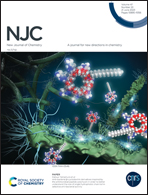Chiral recognition during adsorption on MOF [{Cu12I(trz)8}·4 Cl·8 H2O]n, obtained from achiral building blocks without an external source of chirality†
Abstract
The chiral recognition ability of microporous MOF [{Cu12I(trz)8}·4 Cl·8 H2O]n in adsorption processes was studied. The MOF sample was obtained from achiral molecules in the absence of an external source of chirality. It has, in its structure, a right-handed single-stranded helix nanotube with a size of 14 Å and a left-handed single-stranded helix nanotube measuring 4.9 Å. The aim of this study was to use substances capable of adsorbing only in one type of nanotubes. This could lead to chiral recognition by racemic crystals. To test the recognition ability, the enantiomers of limonene were used. The limonene dimensions were too large to fit in the left-handed nanotube but small enough to get adsorbed by the right-handed nanotube. To analyze the enantioselectivity of [{Cu12I(trz)8}·4 Cl·8 H2O]n, inverse gas chromatography was used. The specific retention volumes were calculated and the adsorption isotherms were plotted. In addition, the MOF sample was characterized by XRD, IR spectrometry, and porosimetry analyses. It has been shown that the MOF-based stationary phase was capable of chiral recognition. The maximum selectivity coefficient was 1.43. The reliability of differences in enantiomer adsorption isotherms was confirmed by t-test. The data obtained proved the chiral recognition ability. During adsorption data collection, a decrease in enantioselectivity was observed. It was caused by the irreversible (under gas chromatography conditions) adsorption of the limonene enantiomers in the MOF pores. This fact was confirmed by eluting n-heptane through a MOF column after a gas chromatographic experiment. Furthermore, irreversible nitrogen adsorption was observed during the porosimetry experiment.
![Graphical abstract: Chiral recognition during adsorption on MOF [{Cu12I(trz)8}·4 Cl·8 H2O]n, obtained from achiral building blocks without an external source of chirality](/en/Image/Get?imageInfo.ImageType=GA&imageInfo.ImageIdentifier.ManuscriptID=D3NJ01448G&imageInfo.ImageIdentifier.Year=2023)


 Please wait while we load your content...
Please wait while we load your content...